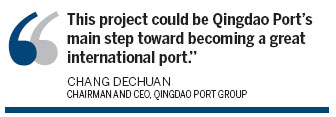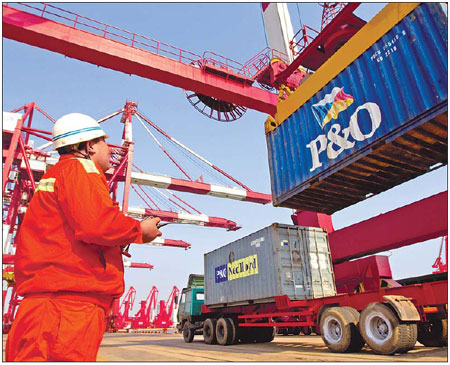Business
Qingdao Port plans to be regional hub
Updated: 2011-02-24 07:51
By Wang Ying (China Daily)
|
A worker helps load cargo containers in Qingdao Port. Provided to China Daily |

It plans 30b yuan investment to help it outpace rivals
SHANGHAI - Qingdao Port is seeking a more ambitious position among its major Northeast Asian rivals as it tries to transform itself into a regional shipping center offering premium businesses in cargo handling, logistics and related industries.
"Over the next five years Qingdao Port will add 300 million tons of capacity to augment throughput to 600 million tons and 20 million TEUs (20-foot equivalent units) of containers by the end of 2015," Chang Dechuan, chairman and chief executive officer of the Qingdao Port Group, told China Daily.
Located in Jiaozhou Bay on the southern tip of Shandong Peninsula, the port is the world's seventh-largest by throughput and the eighth-largest container port. In 2010, it handled a total throughput of 350 million tons and container throughput of 12 million TEUs.
But its management looks beyond these accomplishments, especially as a group of neighboring rivals - such as the Chinese ports of Tianjin, Yantai and Dalian, and South Korea's Busan - are also quickly developing and eroding its advantage in certain sectors.
With a total area of 10.56 square kilometers, Qingdao Port is less than one-fourth the size of other domestic ports, undermining its efforts to become a major bulk-cargo shipping center and regional shipping hub.
It has been overloaded for some time, handling more than the 150-million-ton maximum capacity it was designed for. Expansion of its facilities is high on the agenda.
According to Chang, the port will invest 30 billion yuan ($4.56 billion) to achieve its goal of becoming Northeast Asia's regional shipping center.
Chang said that by 2015 Qingdao Port will comprise four port areas: The Dongjiakou area will serve as a shipping and storage center of bulk cargo and energy; the Qianwan port will be a container shipping hub in Northeast Asia; the Huangdao port will be an oil product and chemical logistics hub; and the old port will handle grains, chemical fertilizer, steel, aluminum, equipment, cold chain shipping containers and feedstuff.
In 2010, the Port of Qingdao maintained its leading position in raw-material handling. It is the world's largest iron ore port, and China's largest import port for crude oil.
It has completed the construction of a 300,000-ton crude-oil dock, and a 300,000-ton ore dock in Dongjiakou port is under construction. "We are always paying attention to state-of-art facilities, and with the renovated hardware, we are able to reshuffle the nation's shipping industry," Chang said.
Chang revealed that the funding for all the expansion projects will be raised by the port itself. Aside from dock construction, the money will also be used to introduce new technologies and restructure work processes. "This project could be Qingdao Port's main step toward becoming a great international port," he added.
Over the years, the port has focused on developing the container sector, with cooperation from investors from home and abroad.
Its container branch involves international investors, including the world's largest container ship and supply vessel operator, Denmark's AP Moller-Maersk Group, the British shipping giant P&O Group, China Ocean Shipping (Group), and China Merchants Group.
"This is a great model for cooperation," Chang said. With the combined investment, Qingdao Port is expected to surpass South Korea's Port of Busan to become Northeast Asia's market leader in terms of throughput within the next two years.
China Daily
Specials

Kremlin buddies
Dmitry Medvedev and Vladimir Putin inspect Olympic preparations.

Lantern Festival
The Lantern Festival is celebrated across China.

New York Fashion Week
Models line up before a show during New York Fashion Week.
